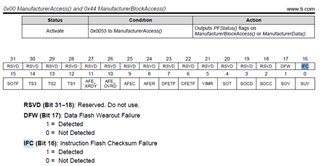Other Parts Discussed in Thread: BQ78350
Tool/software:
Dear TI Team,
We have been notified of existance of a IFC(Instruction Flash Checksum Failure ) in one of our e-bike product after a couple of usage in the field. This is the first time we faced with this failure , which is seen only at one product.
Upon this failure I have checked the following e2e threads from the forum.
- https://e2e.ti.com/support/power-management-group/power-management/f/power-management-forum/862688/bq78350-r1-bq78350-r1-manufactureraccess-0x0005-static-df-signature-failure/3192156?tisearch=e2e-sitesearch
- https://e2e.ti.com/support/power-management-group/power-management/f/power-management-forum/689090/bq78350-r1-permanent-fail-ifc-flag?tisearch=e2e-sitesearch&keymatch=bq78350%2520IFC#
- https://e2e.ti.com/support/power-management-group/power-management/f/power-management-forum/950431/bq78350-r1-flash-data-loss-corruption?tisearch=e2e-sitesearch&keymatch=bq78350%25252520IFC
When I inspected the responses given to threads mentioned above , I saw that there has been an improvement in instruction flash checksum calculation in R2 gauge firmware. This change is cited from "bq78350-R1 TRM Addendum for the bq78350-R2 Device" at given responses. Before taking any action on devices at the field, we would like to take information about following questions.
- Has IFC failure seen randomly at BQ78350 products with R1 firmware? Is there any scenario that triggers IFC error more frequently besides reasons mentioned in previous threads?
- Is there a possibility for IFC error to occur at ideal implementation later? Could we ensure that IFC error will not occur in a product that has been used within defined limits with R1 firmware?
- Had IFC error seen in devices with R2 firmware given they operate within defined conditions? Will R2 gauge firmware update provide a certain solution to IFC error?
Information about Gauge IC , system status and logs taken from faulty system is listed below. This logs are read from Gauge IC by E-bike battery MCU and formatted accordingly.
Gauge Hardware : Bq78350_R1
Gauge Firmware Version : bq78350_R1_v1_04_build_26 1.srec
|
Permanent Failure |
0x10000 |
|
Protection |
0 |
|
Cell1 Voltage |
3917 |
|
Cell2 Voltage |
3913 |
|
Cell3 Voltage |
3919 |
|
Cell4 Voltage |
3921 |
|
Cell5 Voltage |
3922 |
|
Cell6 Voltage |
3911 |
|
Cell7 Voltage |
3919 |
|
Cell8 Voltage |
3917 |
|
Cell9 Voltage |
3916 |
|
Cell10 Voltage |
3907 |
|
Max Cell Temperature |
19 |
|
Min Cell Temperature |
8 |
|
FET temperature |
8 |
|
Current at PF |
0 |
|
Remaining Capacity |
0 |
|
Full Capacity |
9000 |

We would appreciate a fast response for our diagnosis , planning and informing processes. Thank you for your interest.


